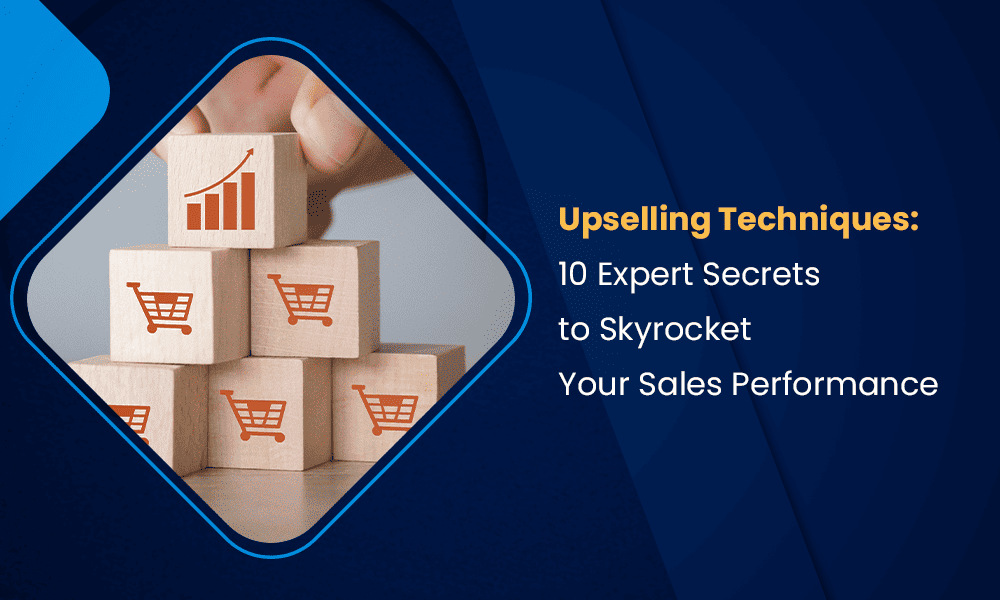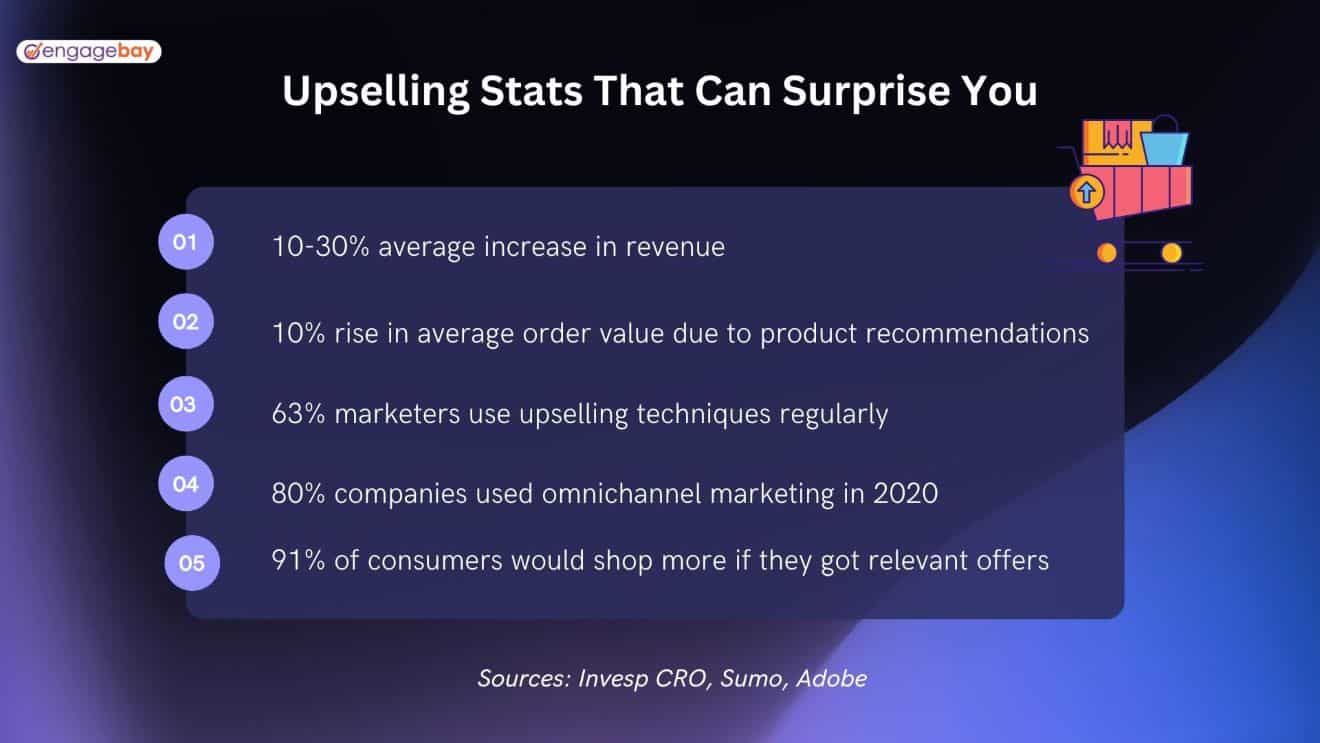If you work in eCommerce or SaaS industries, you’re already familiar with upselling techniques.
But, upselling hasn’t always enjoyed a good reputation. If the word “upselling” reminds you of salespeople in coats who are coaxing customers to buy what they don’t need — this article is for you!
This couldn’t be farther from the truth. When upselling is done carefully and effectively, it can be a win-win situation for your customers and your company.

In fact, on average, an eCommerce company earns 10-30% of its revenue using upselling techniques and strategies. Some eCommerce giants like Amazon make over 35% of their revenue through upsells and cross-sells.
We’re here to help you navigate the upselling process. This article will help you:
- Define upselling
- Highlight the major benefits of upselling
- Outline the differences between upselling, cross-selling, add-ons, and bundle sales
- Understand the four steps to identify upselling opportunities
- Identify whether upselling is ethical and which FTA laws apply
- Understand 10 proven upselling techniques to boost revenue
Let’s get right into it.
Table of Contents
What is Upselling?
Upselling is the process where prospective buyers are encouraged to purchase or spend on a higher-value product.
Let’s say you’re an eCommerce company selling wireless headphones. You have one pair of headphones available for $100.

But, based on the prospect’s browsing history, you offer a product recommendation for noise-canceling headphones at $150. If the prospect was looking for this feature, you’ve now made a sale for $50 more than you originally would have.
Here’s another example.
When I search for any book on Amazon, I get recommendations for other books I’m likely to enjoy based on my browsing and purchase history. So, instead of buying one book as planned, I spend more on books due to great recommendations 😅

According to a recent Forbes study, 58% of customers are willing to pay more for better customer service alone! Let’s find out the other benefits of upselling for SMBs.
Read also: 11 B2B Sales Techniques Your Business Should Use
How Does Upselling Help SMBs?
Now you know how upselling works. But, how exactly do upselling techniques help companies? Here are some of the major advantages of upselling for eCommerce and SaaS companies.
Increased revenue
Let’s say you convinced one customer to buy an iPhone Max Pro instead of an iPhone Max. This means you’ve increased the profitability of this sale.

There’s another way of doing this too. If the customer still chooses an iPhone Max, then you can offer them an extended contract period of 12 months instead of 6 months. Either way, you get a better profit margin.
According to a research analyst from Forrester, 10-30% of the total market revenue is generated by upsells. So, don’t let your company miss out. This is true for SaaS companies too.

Improved customer lifetime value
Customer lifetime value (CLV) is a measure of how valuable a customer is to your company during the entire course of their relationship with you.
Academic studies have proven that upselling increases the average customer lifetime value to your company. Upselling doesn’t just improve your profit margin for the first purchase. It increases your customer’s average order value.
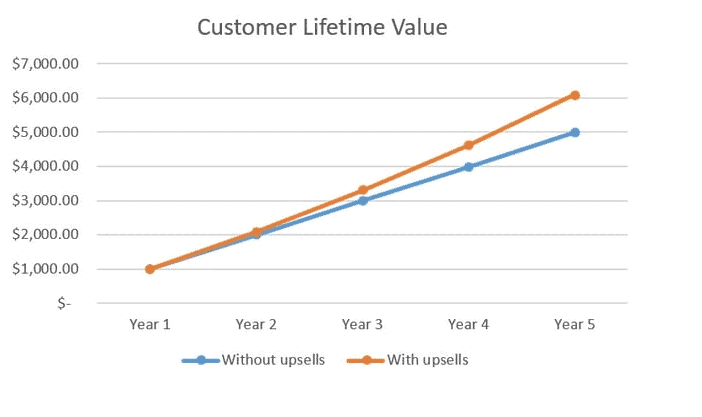
And, the more brand satisfaction your customer gets, the more they will continue to spend on your products and services. This creates a great feedback loop where upselling boosts customer satisfaction and revenue.
Reduced marketing costs in the long run
Upselling to your existing customers is far easier and cheaper than acquiring a new one. In the long run, upselling can help you save your advertising and marketing costs. Here’s an interesting infographic from Groove.
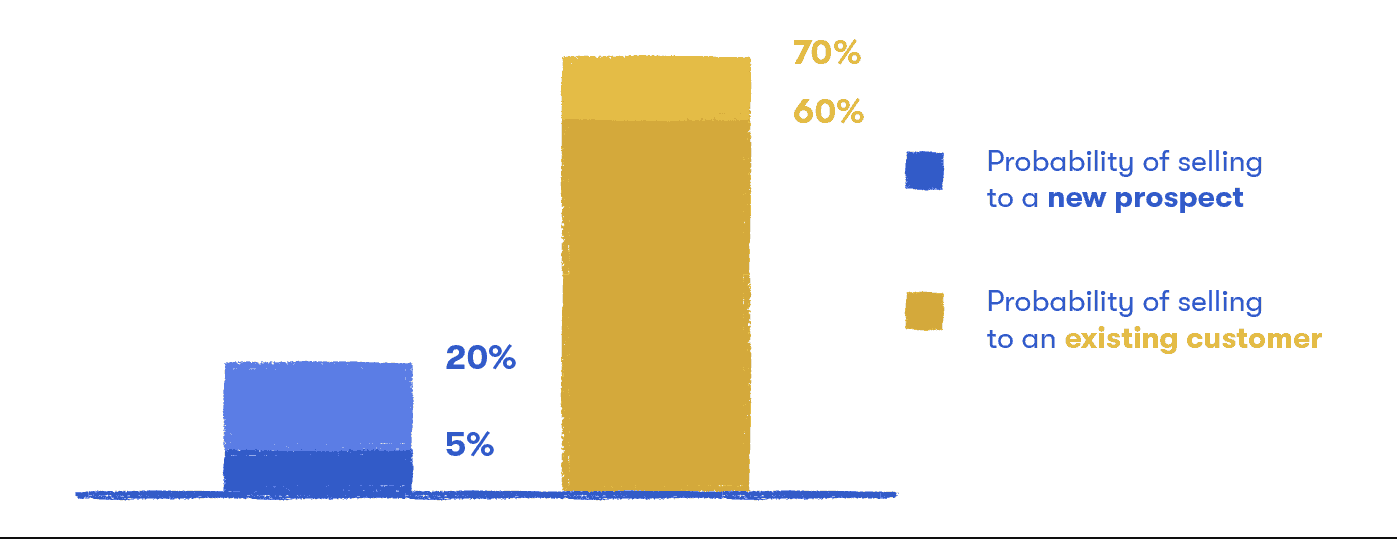
Let’s talk numbers now.
- On average, it costs 5-25 times more to acquire one new customer than it does to upsell to an existing customer.
- And, existing customers spend 67% more than new customers.
- A mere 5% increase in customer retention can lead to up to 25% more earnings.
Better inventory management
Upselling and cross-selling techniques can improve your inventory management process.
How would you do this?
By upselling and cross-selling related or complementary products, you’re also optimizing your product mix. You’ll get actionable insights into which products are a hit with your target audience.
You can also identify certain times of the year when a particular product is more in demand. This will help you purchase patterns and manage your inventory. It also helps you remove outdated or unpopular products from your inventory. Finally, you’ll also be able to reduce your inventory holding costs once you’re sure of purchase patterns.
Read also: 8 Upselling And Cross-Selling Strategies For Small Businesses
Increased customer loyalty and better customer experience
When you upsell and cross-sell products, your customers get a chance to explore products they may not have used before. This creates a sense of novelty and interest among your prospects. When they have a good experience with your company, they are more likely to come back for more.
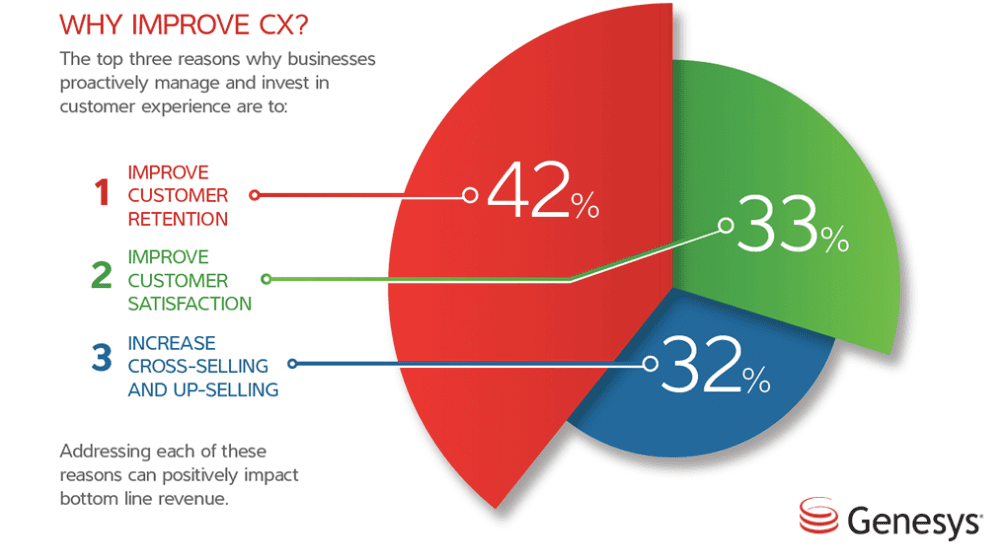
That’s not all. Through upselling, you can provide personalized product recommendations based on customer needs and pain points. With this, your customers feel valued and enjoy doing business with you. All this improves your bottom line.
Gain a competitive advantage with better customer insights
Upselling helps you gain an edge over your market competitors in small yet significant ways. The better you understand customer pain points, the better products and offers you can provide them. This improves customer satisfaction and reduces the churn rate.

At the same time, upselling can also improve your profit margins and total revenue earned. This means a larger marketing and sales budget to help you attract new prospects.
Your satisfied customers can become your informal brand ambassadors. This creates a positive cycle for both you and your customers — while giving you an edge over the competition.
So now you know the key benefits of upselling. But, we’ve mentioned cross-selling quite a bit already in this article. If you’re not sure about cross-selling, we’re breaking this concept down next.
Upselling vs Cross-selling: What’s the Difference, Exactly?
So, what exactly is cross-selling? And, how is it different from upselling? The answer lies in the name itself.
Cross-selling is the process of driving the sale of complementary or related products in addition to the original product.
Here’s an example. Let’s say you’ve added a razor to your cart from the Dollar Shave Company. Now, upselling would mean suggesting a premium razor for a higher price. But, cross-selling would give product recommendations like shaving creams or after-shave colognes.

So, what’s the bottom line?
Upselling aims at increasing the actual value of the one-time sale and increasing profit margins. But, cross-selling seeks to increase the value of sales over time by suggesting related products.
What about add-on sales and bundle sales? Is it the same as upselling?
Let’s clarify how add-on sales and bundle sales are different from upselling.
Add-on sales on products and services refer to services that complement and enhance the primary product. These add-ons are related to the product, but they’re not always upgrades.
For example, if you’re selling laptops, then an add-on service could be an extended warranty or tech support subscriptions. Here’s an example from Amazon 👇

Bundle sales is a strategy where you recommend two or more related products that complement each other to drive more sales.
Marketers usually make it very easy for buyers to find these related products and add them to the cart as a bundle. Often, customers can get discounts for bundle purchases.
When you buy the new Playstation 5 on Amazon, you get a bundle sale recommendation for an extra controller or a charging station. Here’s how it looks 👇

Now, add-on sales and bundle sales are great strategies to increase the customer lifetime value and average order value. But, there’s a caveat here.
According to research by Harvard Business School, bundle sales are the most effective when the individual items are available separately as well.
In the study, academics from Harvard studied Nintendo’s practices of bundle sales. To their surprise, they found that Nintendo sales were higher when bundle sales and individual sales were both available to the customer. This “mixed bundling” was found to drive sales much faster.
Read also: 6 Killer Sales Tips for Getting the World to Say ‘Yes’
4 Steps to Identify and Leverage Upselling Opportunities
Here’s how you can begin to identify every opportunity for cross-sells and upsells. You must master these steps because your upsells will boost revenue for years to come. Let’s get started.
1. Gather customer behavior data to identify patterns and trends
The first step of this process is to gather all your customer profiles and behavior data into one centralized database. A CRM solution or a lead management platform will help you do just this.
Start by creating your Ideal Customer Profile (ICP). And, you’ll also need to create relevant buyer personas. This will give you a sense of where your ideal paying customer stands. It will also give you insight into what kind of customers are unlikely to make a purchase any time soon.
Then, use a tool like Google Analytics to pull up website visitor data for your eCommerce store. 👇
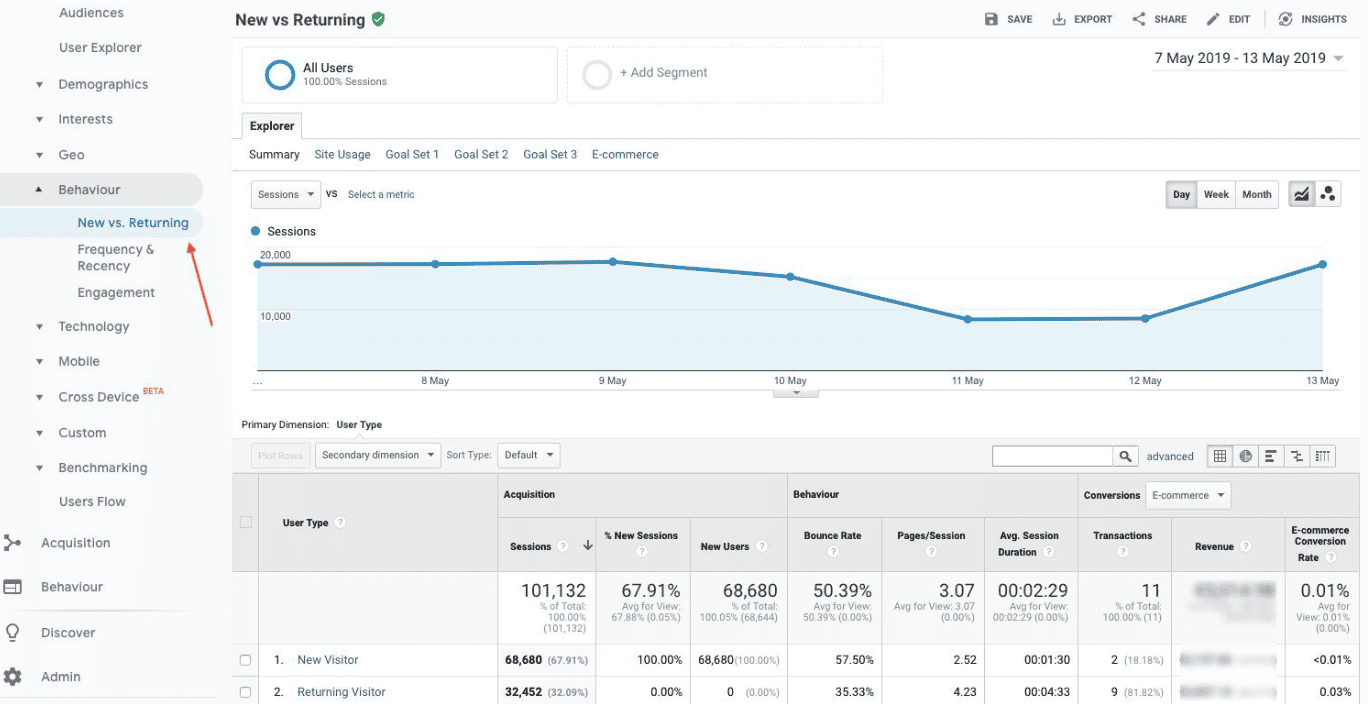
Here are some of the most important metrics to track from Google Analytics:
- Total website visits
- Organic vs paid traffic
- New vs repeat visitors
- Website heatmap analysis
- Page views
- Purchasing trends
- Conversion rates
Apart from this data, we also recommend that you monitor your social media feeds for any mentions. Find out what customers are saying about your products.
2. Monitor each product’s performance and analyze the results
Next, you’ll have to monitor the performance of each product in your inventory. This will give you a wealth of insights into purchasing patterns and trends.
You’ll need to have a clear idea about which products are performing the best. Then, you can create bundles of related products to upsell based on customer segmentation.
3. Conduct open-ended surveys to understand customer pain points
This is a crucial step. The best way to get to your target customer is to simply talk to them!
So, conduct a few open-ended surveys. This could include information related to your products, your website, the checkout process, and overall customer satisfaction. With these surveys and your analytics data put together, you’re now ready to understand the major customer pain points.
Now, think of how other premium products can solve these pain points. This data will be crucial to the success of your upselling strategies.
4. Let automation help with personalized recommendations
If you don’t leverage the power of marketing and sales automation, then you’re making your job much harder than it has to be.
With automation, you can set up workflows to take action whenever pre-set conditions are met. You can design intelligent workflows using marketing automation software or a customer relationship management (CRM) platform like EngageBay. 👇

Here are just some ways automation can help you upsell:
- Product recommendations
- Personalized promotions and offers
- Displaying retargeted ads
- Personalized email marketing messages
- Cart abandonment reminders or emails
- Post-purchase follow-up messages
And, once you have your buyer personas ready, you can then segment your target audience based on purchase history, interests, and demographic factors. You’ll need to ensure that only relevant products reach your target audience to be upsold.
Read also: 6 Easy Ways to Spot (& Create) New Sales Opportunities Like a Boss
The Ethics of Upselling: Is it ‘Bait-and-Switch’ Marketing?
Before we look at upselling techniques, let’s ponder a slightly philosophical question — is upselling ethical? Or, would upselling be considered a “bait-and-switch” marketing technique?
Here’s the good news: upselling is indeed ethical, if you do it correctly. But, there are situations where upselling may inadvertently fall into the category of “bait-and-switch” marketing. And, we’re here to help you avoid this pitfall.

“Bait-and-switch” marketing works like this.
First, a company places a misleading or inaccurate ad to attract the maximum number of leads. This is the “bait”. Then, when prospects show interest, the company “switches” its strategy to convince them to buy expensive or unnecessary products.
This is an unethical practice if your upselling techniques inadvertently devolve into “bait and switch” marketing. According to the Federal Trade Commission (FTC), “bait-and-switch” marketing involves deception and is therefore illegal.
The FTC considers a marketing message deceptive if there is “representation, omission, or practice that is likely to mislead the consumer acting reasonably in the circumstances, to the consumer’s detriment.”
So, the first step is to be crystal clear and only promise what your product can deliver. Second, if a prospect reaches out, you’ll need to do your due diligence in explaining the features or offering a demo. Here’s a breakdown of the full FTC guidelines as published in the Marketing Science journal 👇
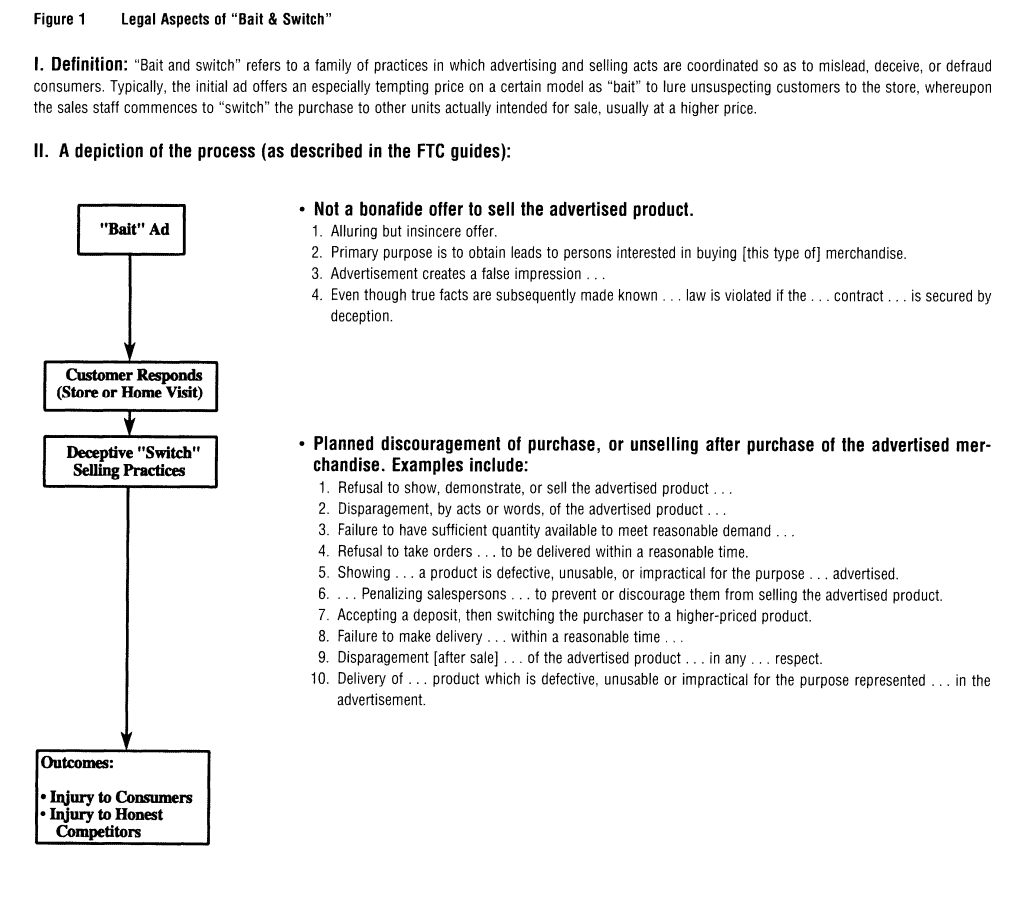
Read also: 17 Powerful Techniques to Generate B2B Sales Leads
10 Proven Upselling Techniques to Drive More Sales
Here are some time-tested and proven upselling techniques for you to consider today. It’s all about striking a balance between driving more sales and providing a seamless customer experience from start to finish.
1. Give customers multiple options for products and discounts
The first upselling technique is also the simplest. When you’re upselling — offer a range of premium products and discounts.
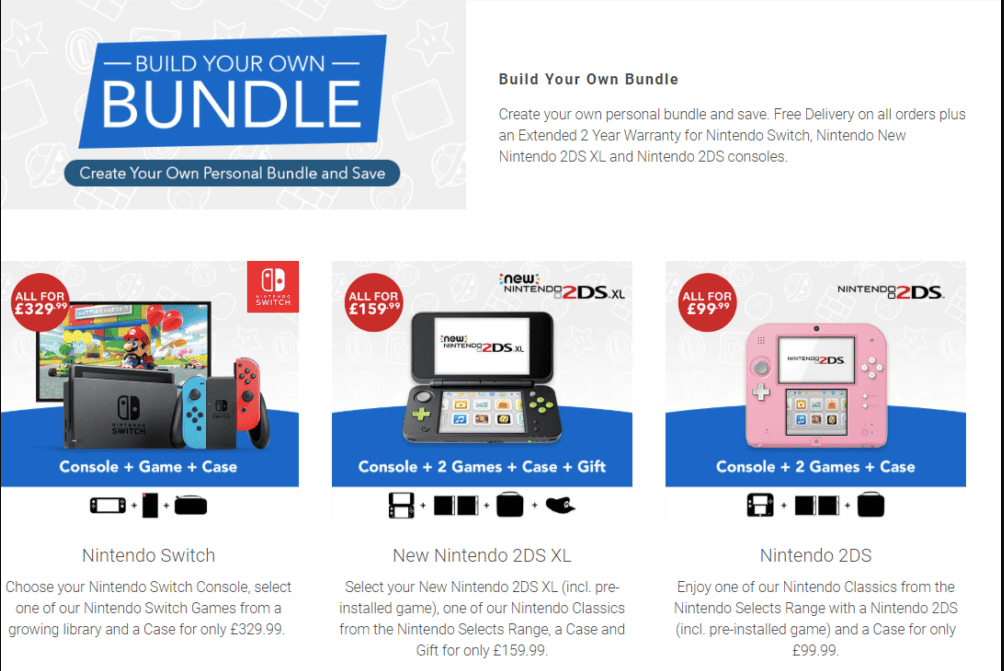
This is how this technique can help:
- Put choice in the hands of customers: The customer can choose the upsold product that meets their needs or desires in the best way. Customers may discover new products they were unaware of too. This improves customer satisfaction.
- Cater to a variety of customer budgets: Not everyone who fulfills the criteria for the ideal customer profile (ICP) will have the same budget at all times. This allows customers to spend only what they are capable of on a given day.
- Increase cross-selling opportunities: When you offer a variety of products, your chances of cross-selling related products also increase. If a customer has purchased a premium product, then they are also likely to buy related accessories or extended warranty periods.
- Increase the perceived value of upsold products: When you offer a wide variety of upsold products, it improves their perceived value in the customer’s mind. If the premium product solves certain pain points, then they are more likely to purchase it.
- Offer discounts or free shipping whenever possible: Customers are more likely to buy a premium product when it’s combined with free shipping or a discount. 95% of customers say that free shipping encourages them to spend more on eCommerce websites.
2. Don’t oversell or give too many choices. Try to help instead
When you’re upselling your products — there’s something called “too much choice.” When there are too many options for customers to choose from, this creates a certain paralysis in their minds.
This has been proven by research as well. In one popular survey, academics studied the conversion rates of two pop-up stores selling similar products. One store had only 6 options for customers, while the second store had over 24 options.
The researchers found that while more people visited the store with 24 options, only 3% of the visitors made one purchase. For the store with fewer options, 30% of visitors made a purchase. That’s a huge difference in the conversion rate.

So, instead of aggressively marketing your premium products and offering too many options, limit the number of options instead. Try to help customers solve their pain points rather than push your products.
3. Ensure that upsold products aren’t too expensive
Now, when you’re trying to get a customer to upgrade to a premium product, the goal is to help them achieve a quick win.
This won’t be possible if the price range of your premium product is too expensive for your client’s budget. As a rule of thumb, experts suggest that customers are rarely willing to spend more than 25% of what they’d originally planned to spend. Here’s a great example 👇
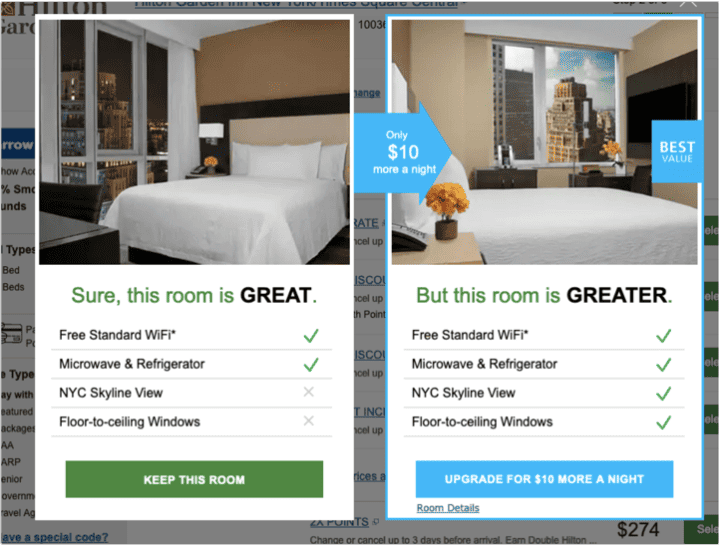
Here, the value of the premium room is just $10 more than the original room. But, the customer gets the added benefit of a better view and floor-to-ceiling windows if they choose the premium room.
The success of this upselling technique rests on the fact that customers believe they’ll get added benefits for a reasonable cost.
4. Use personalization to enhance customer experience
No customer wants to feel like they’re just a number on your marketing dashboard. To build better customer relationships, personalized product recommendations can be a game changer.
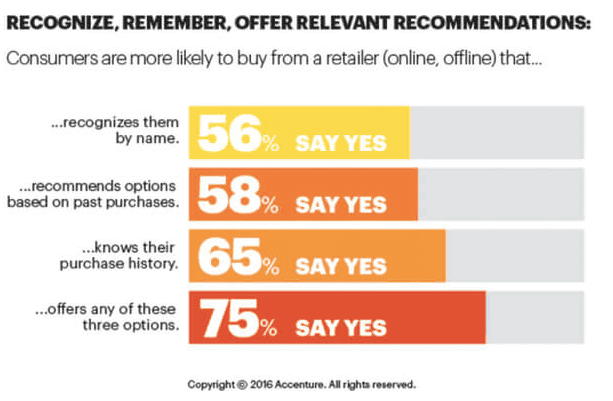
Here are some ways personalization can help your upselling strategies.
- Access to better customer segmentation. Before personalizing recommendations, you’ll first get access to better segmentation data based on personal information and behavior history.
- Offer tailored recommendations. Using algorithms and machine learning, you’ll be able to recommend products based on customer interests and behavior. This improves the chances of conversions.
- Send personalized marketing messages. At each stage of the buyer’s journey, you’ll be able to send relevant and targeted marketing messages.
- Provide incentives that work. Based on a wealth of customer data, you’ll be able to curate personalized incentives for each segment of your target audience.
5. Use persuasive language to highlight the product’s value and create urgency
The kind of language you use matters almost as much as the product you are upselling. One caveat is never to go overboard or appear aggressive or pushy when it comes to upselling. You’ll gain more by merely giving suggestions to your customers.
Use only persuasive language in your upselling product page copy or landing page copy. Instead of saying something like, “This phone has a larger memory storage,” you could say, “Save over 1 million photos on your phone”. The value proposition is an important factor here.
Remember to clearly and convincingly highlight the benefits and value of the upsold products. And, you can also create a sense of urgency with limited-time offers or discounts. Here’s an example 👇
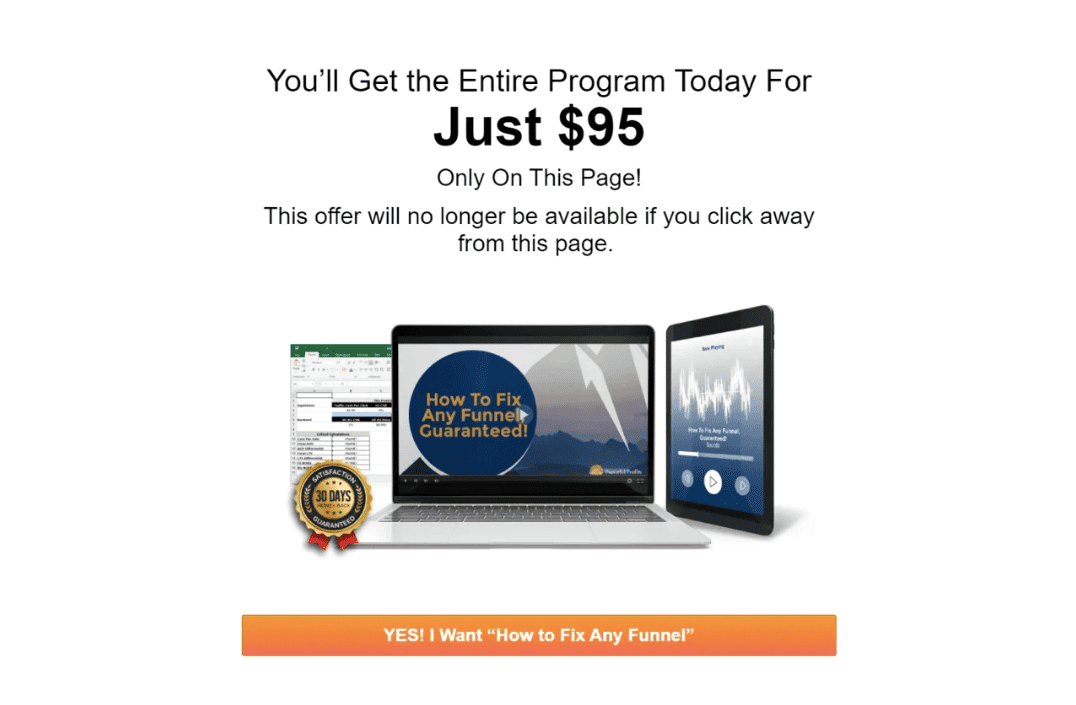
6. Provide an easily accessible comparison feature
If you’re serious about upselling your premium products, then consider creating a comparison feature on your website.
Ideally, this segment can allow customers to manually add multiple products and compare their features and price. Or, you can offer customers a comparison of the product they intend to buy and the premium product without any manual additions.
This will help your customers make an informed decision. They’ll be aware of exactly how much they’re paying for additional features or an upgrade.
Rather than pushing an upsold product, try giving customers enough information to make the right choice for themselves. Here’s an example from Amazon’s product comparison segment 👇

7. Add a “related products” section to your checkout page
Another great way to boost upselling in your eCommerce website is to add a ‘Related Products’ segment to your checkout page.
Here’s the logic behind this. If a prospect has reached the checkout page, then they’re likely to complete that purchase. As they decide to buy this product, you can offer product suggestions that will enhance and complement the original product.
For example, if you’re selling a camera, then consider offering memory cards, bags, or tripods in the related product category. Here’s an example 👇

8. Take advantage of social proof
Here’s an excellent quote about why social proof is so important.
“When you say it, it’s marketing. When your customer says it, it’s social proof.”
~ Andy Crestodina, Orbit Media
This makes sense, right? And, research has backed this statement time and again.
Surveys show that over 82% of Americans ask for recommendations about a product before buying. And, an average American customer will read 40 reviews before being convinced about a product.
Social proof and user-generated content (UGC) are great ways to establish trust with new prospects. It shows new customers that your company is reliable. Here’s how this could look.
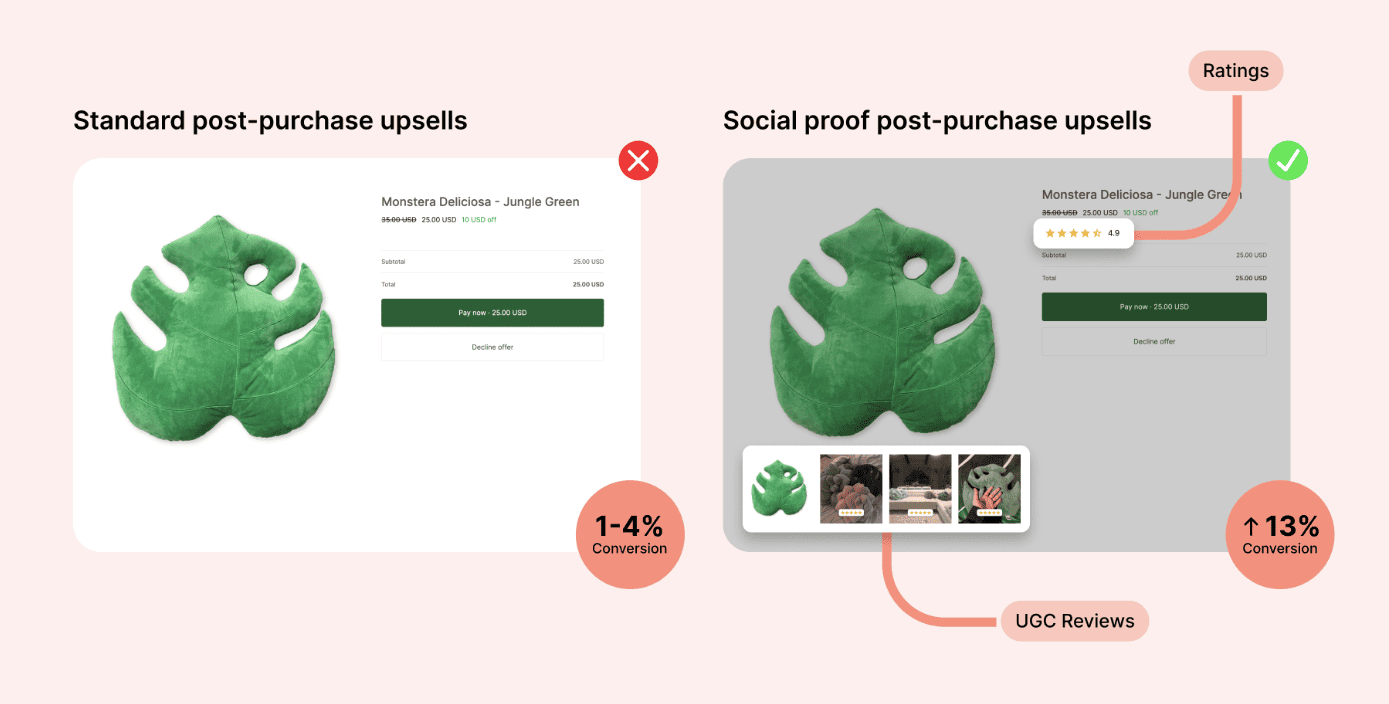
9. Upsell products at each stage of the customer journey and on different pages
You don’t have to limit your upselling efforts to just the checkout page. Ideally, your upselling strategy should include all stages of the customer journey. And, you can feature different related products on different pages of your website.
Marketers typically place their upselling suggestions on product pages, checkout pages, and the add-to-cart page. You can also add bundled products to your homepage.
Here’s how you can leverage each stage of the buyer’s journey for upselling. Remember that it depends on your mapping of the buyer’s journey, and this is a general schema.
- Pre-purchase stage: At this stage, your best bet is to show customers personalized or retargeted ads with product recommendations based on their history and past behavior.
- Consideration stage (product page and cart page): At this stage, you can offer suggestions for complementary products and services. Offer time-sensitive discounts or free shipping on the cart page when you want to boost conversions.
- Decision stage (checkout page): At this stage, cross-selling can work wonders for you. Continue to offer personalized product recommendations for upsells too.
- Post-purchase stage (follow-up emails or calls): In the post-purchase stage, you can give customers the option of adding more products to their existing orders for free. Follow up with all your customers at this stage. Only offer recommendations if they are satisfied.
10. Be ethical and never let customers feel ‘tricked’
When it comes to upselling techniques, remember to remain ethical in all your dealings.
You’ve given product recommendations. You’ve provided all the information a prospect would need to make an informed decision about their purchase.
Remain upfront about all the advantages. But, never make the mistake of overselling your product or promising results that the product cannot deliver. Remember that even if a few customers feel like they were misled or taken advantage of — it will impact your brand image negatively.
Read also: 5 Sales Tools and 6 Sales Techniques That Always Work
Conclusion
Whether you’re in the SaaS industry or the eCommerce industry, we’ve seen how upselling can instantly improve your sales and revenue.
Also, when your loyal customers get excellent product recommendations based on their needs and interests, it builds a great customer relationship over time. When done correctly, upselling is not just an ethical practice. It also translates into a win-win situation for the company and its customers.
If you have more doubts about leveraging the power of upselling using a CRM platform, get in touch with our team for a demo. We’re happy to help.
